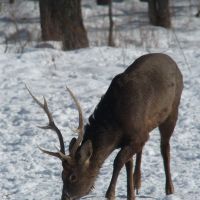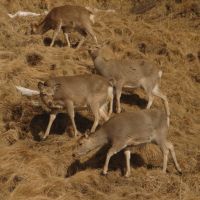Deep powdery snow is to a Sika Deer what a stage covered with fluffy feather pillows would be to a top-ranking ballerina. Both lead to loss of grace and floundering, for slim-footed deer and ballerina alike.
Where narrow-hooved deer sink and flounder in snow, by way of contrast wild boar plough like manic bulldozers leaving deep furrows in the snow. Hares, with large hind feet, and densely furred toes giving them broad surfaces like mini-snowshoes, skim fleet-footed over the snow, as did the elf Legolas in JRR Tolkien's "The Lord of the Rings."
In southern Japan, the image of Sika is of a small, rather delicate creature, whereas in the north, where I live, they are large and more heavily set. Despite regular visits to the southern islands, I am nevertheless surprised each time by the difference in size between the northern and southern populations.
Southern Sika are darkly pelaged in reddish-brown. They are diminutive animals of forest and forest edge, spending much of their time browsing anonymously in the dark forests of the Laurelacaea trees that predominate there. The smallest of all live on the southernmost islands: Kerama, off Okinawa, and Yakushima, south of Kyushu. On Yakushima, they share their range with the southernmost Japanese Macaques and live with them in a loosely symbiotic way, as do Spotted Deer and Common Langurs in India.
Monkeys and deer alike live in social groups and quickly give alarm calls when disturbance or danger threaten. Deer and monkeys each understand and respond to the other's alarms. It is the deer that reap the further benefit though, because monkeys are messy eaters. As macaques climb into trees they select only certain leaves or fruits up in the canopy and they send a steady rain of detritus, discarded leaves and the like, to the forest floor below.
To the deer, the miraculous appearance of fresh food from above must seem like manna from heaven, a kind of cervine fantasy on a par with Judi and Ron Barrett's tale in their book "Cloudy with a Chance of Meatballs" and the 2009 computer-animated comedy fantasy film based on it.
Miraculous provisioning is not confined only to the deer on Yakushima, and though macaques are not usually involved elsewhere, another kind of primate is: With the passion that human visitors here have of feeding living creatures at tourist spots, deer that overcome their shyness sufficiently to approach are guaranteed handouts.
A little further to the north of Yakushima, but belonging to the same national park, the Kirishima mountain range of Kyushu is home to another, only slightly larger subspecies of deer.
In many parts of Kirishima's forest, the only signs of deer are their sharply whistled alarm calls, the sound of hooves and if lucky a glimpse of their large white rump patches neatly framed with black as they dash away in fright. At some spots, though, regular visitor handouts have drawn deer out from the forest and some have become confiding enough to take proffered food from visitors. The same has happened at Itsukushima Shrine on Miyajima and at Nara.
Moving northward through the Japanese archipelago, Sika Deer populations, recognized by biologists as separate subspecies, become increasingly large, and to my eye paler brown. All of the subspecies share a number of fundamental features in common, and in fact these familiar characteristics are to be found in most other deer species too.
The males grow a fine set of antlers that they use essentially for bluff and bravado during the autumn rut, though sometimes they are also used for outright clashes. Then, the clattering and rattling sound of the antlers of jousting stags is dramatic indeed. The males strut and pose with their fine racks of antlers, hoping to oust their competitors in the race to pass on their genes. The larger-bodied males with larger antlers dominate, give stirring territorial calls and gather about them a harem of females with which they mate.
After the seasonal rut, when the extra burden of their spreading antlers no longer serves a purpose, the stags drop them, like a deciduous tree shedding its leaves. The fallen antlers become an important source of minerals for other creatures. Should you find one on the forest floor, inspect it closely and you'll almost certainly find the tiny tooth marks indicative of rodents gnawing there, or perhaps even larger tooth marks of a fox, badger or deer. It's tempting to take fallen antlers as decorations, but they serve a better purpose left on the forest floor, where their minerals are consumed or eventually leach back into the soil.
It is this characteristic, of growing a new set of antlers each year and dropping them again, that distinguishes deer immediately from other animals with horns, such as sheep, goats, cattle and antelopes. Those animals, unlike the deer, have simple, nonbranching structures of bone, covered with keratin, on their foreheads and they keep them throughout their lives.
While male and female deer differ in that males have antlers and females don't, they each have similarly short tails, which they raise when disturbed, and white fur on their rump, which they fluff out in alarm. The combination of raised tail and fluffed white bottom makes for a strong visual signal, especially in a shady forest or poor light, allowing disturbed herd members to follow one another easily. They also share a sharp, whistled alarm call, which, despite having heard it innumerable times, still gives me a jolt of surprise.
If you have only encountered deer in Japan in the parks in Nara or on Miyajima, then it is only the most approachable of deer that you have encountered. These are in fact deer with attitude: They don't just hope for food; they expect it. If you don't provide it, they are quite likely to steal your map or pamphlet from your hand or pocket. Never, ever, put down an open bag in sight of these particular deer, as that is giving them a confirmed invitation to dinner!
Some others of Japan's deer are wild, nervous of hunters, but increasing in numbers — I am talking about the deer in Hokkaido.
Last weekend I arrived at my favorite pension in west Hokkaido to find myself immediately welcomed to the shōchū bottle and embroiled in a debate about the fate of deer here, and more importantly what we should do about them. It's a serious subject up here, as the deer population is perceived as exploding out of control, causing damage to agriculture and vehicles, and to life and limb on the island's road and rail networks.
Always willing to stir up trouble, I suggested that reintroducing wolves might help — as the deer's only native predator was exterminated a little over a century ago.
Then I was struck with another idea: Just to the west, on the Russian mainland and along its border with China, the few remaining Siberian Tigers left on earth are battling to survive against increasing odds of extinction from poaching and habitat loss. How about solving two problems in one? Help save the tiger by translocating Siberian Tigers to Hokkaido — the habitat is very similar — and help reduce the deer population by introducing a predator. One could even help the flagging tourist trade, by operating tiger-watching tourism in Japan (why should India have all the fun?). Of course, this off-the-wall idea is untenable in a number of ways: Imagine trying to obtain local community consensus for introducing tigers in their forests. But don't throw out the idea entirely; at least not yet.
In New Zealand, deer were initially introduced as game animals, and once their population became out of control, various methods were attempted to control them. One involved fencing them in and farming them for velvet, antler, bone, skin and meat for international markets extending from Europe to China.
Something similar could be done in Hokkaido on a commercial scale by fencing in some of the wild Sika. Then in some large fenced areas with plenty of deer, Siberian Tigers could be introduced. Now wouldn't that be a sight — to watch a striped tawny-orange beast stalking deer through the snowy wastes of Akan or Daisetsuzan national parks! If there were tigers around, perhaps folk wouldn't worry so much about the deer.
Mark Brazil is a naturalist and author who has written Wild Watch for 29 years and is the founder of Japan Nature Guides. His books "Field Guide to the Birds of East Asia," "A Birdwatcher's Guide to Japan" and "The Birds of Japan" are available at good bookstores, or via [email protected] or www.wildwatchjapan.com.




















With your current subscription plan you can comment on stories. However, before writing your first comment, please create a display name in the Profile section of your subscriber account page.